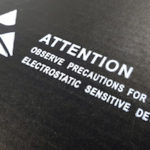Preamble: . As for any organized EMI control, ESD protection consist in anticipating or correcting the unwanted effects of an hostile electromagnetic ambient. Like many EMI threats, ESD manifests through conducted and radiated phenomena, with the latest being often the dominant mode. But there is a unique aspect to ESD, not found in common radiated EMI episodes where the victim box and cables are illuminated by a uniform field. Instead, ESD generates locally a strong field pulse, typically > 1kV/m near the discharge point, dropping quickly as one move away. Therefore, although ESD hardening should be part of a general EMI control, not handled as a separate constraint, some classical EMC solutions may not be sufficient and should be complemented by additional protections.



